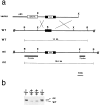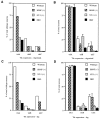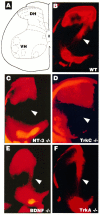Absence of sensory neurons before target innervation in brain-derived neurotrophic factor-, neurotrophin 3-, and TrkC-deficient embryonic mice
- PMID: 9364058
- PMCID: PMC6573597
- DOI: 10.1523/JNEUROSCI.17-23-09113.1997
Absence of sensory neurons before target innervation in brain-derived neurotrophic factor-, neurotrophin 3-, and TrkC-deficient embryonic mice
Abstract
Gene-targeting experiments of Trk receptors and neurotrophins has confirmed the expectation that embryonic sensory and sympathetic neurons require neurotrophin function for survival. They have further revealed correlation between a specific neurotrophin requirement and eventual sensory modality. We have analyzed embryonic and neonatal mice with mutations in the BDNF, neurotrophin 3 (NT-3), and TrkC genes. Our data confirm an unexpectedly high proportion of sensory neuron losses in NT-3 (>70%), BDNF (>20%), and TrkC (>30%) mutants, which encompass populations thought to be NGF-dependent. Direct comparison of TrkC and NT-3 mutants indicates that only a subset of the NT-3-dependent neurons also requires TrkC. The observed losses in our TrkC mutant, which is null for all proteins encoded by the gene, are more severe than those previously reported for the kinase-negative TrkC mutation, implicating additional and important functions for the truncated receptors. Our data further indicate that mature NGF-requiring neurons undergo precocious and transitory requirements for NT-3 and/or BDNF. We suggest that neurotrophins may function in creating early heterogeneity that would enable ganglia to compensate for diverse modality requirements before the period of naturally occurring death.
Figures






Similar articles
-
Characterization of neurotrophin and Trk receptor functions in developing sensory ganglia: direct NT-3 activation of TrkB neurons in vivo.Neuron. 1998 Aug;21(2):325-34. doi: 10.1016/s0896-6273(00)80542-5. Neuron. 1998. PMID: 9728914 Free PMC article.
-
Differential dependency of cutaneous mechanoreceptors on neurotrophins, trk receptors, and P75 LNGFR.Dev Biol. 1997 Oct 1;190(1):94-116. doi: 10.1006/dbio.1997.8658. Dev Biol. 1997. PMID: 9331334
-
Developmental changes in NT3 signalling via TrkA and TrkB in embryonic neurons.EMBO J. 1995 Sep 15;14(18):4482-9. doi: 10.1002/j.1460-2075.1995.tb00127.x. EMBO J. 1995. PMID: 7556091 Free PMC article.
-
Role of neurotrophins and trk receptors in the development and maintenance of sensory neurons: an overview.Philos Trans R Soc Lond B Biol Sci. 1996 Mar 29;351(1338):365-73. doi: 10.1098/rstb.1996.0030. Philos Trans R Soc Lond B Biol Sci. 1996. PMID: 8730773 Review.
-
Neurotrophins in the ear: their roles in sensory neuron survival and fiber guidance.Prog Brain Res. 2004;146:265-78. doi: 10.1016/S0079-6123(03)46017-2. Prog Brain Res. 2004. PMID: 14699969 Review.
Cited by
-
Neurotrophin-4 is more potent than brain-derived neurotrophic factor in promoting, attracting and suppressing geniculate ganglion neurite outgrowth.Dev Neurosci. 2012;34(5):389-401. doi: 10.1159/000342996. Epub 2012 Nov 9. Dev Neurosci. 2012. PMID: 23151843 Free PMC article.
-
The efficiency of design-based stereology in estimating spiral ganglion populations in mice.Hear Res. 2013 Oct;304:153-8. doi: 10.1016/j.heares.2013.07.007. Epub 2013 Jul 20. Hear Res. 2013. PMID: 23876522 Free PMC article.
-
Peripheral and central target requirements for survival of embryonic rat dorsal root ganglion neurons in slice cultures.J Neurosci. 1998 Sep 1;18(17):6905-13. doi: 10.1523/JNEUROSCI.18-17-06905.1998. J Neurosci. 1998. PMID: 9712660 Free PMC article.
-
Mice lacking the p75 receptor fail to acquire a normal complement of taste buds and geniculate ganglion neurons by adulthood.Anat Rec A Discov Mol Cell Evol Biol. 2006 Dec;288(12):1294-302. doi: 10.1002/ar.a.20399. Anat Rec A Discov Mol Cell Evol Biol. 2006. PMID: 17083122 Free PMC article.
-
Spatial shaping of cochlear innervation by temporally regulated neurotrophin expression.J Neurosci. 2001 Aug 15;21(16):6170-80. doi: 10.1523/JNEUROSCI.21-16-06170.2001. J Neurosci. 2001. PMID: 11487640 Free PMC article.
References
-
- Airaksinen MS, Koltzenburg M, Lewin GR, Masu Y, Helbig C, Wolf E, Brem G, Toyka KV, Thoenen H, Meyer M. Specific subtypes of cutaneous mechanoreceptors require neurotrophin-3 following peripheral target innervation. Neuron. 1996;16:287–295. - PubMed
-
- Barbacid M. The Trk family of neurotrophin receptors [review]. J Neurobiol. 1994;25:1386–1403. - PubMed
-
- Barde YA. Neurotrophins: a family of proteins supporting the survival of neurons [review]. Prog Clin Biol Res. 1994;390:45–56. - PubMed
-
- Barker PA, Lomen-Hoerth C, Gensch EM, Meakin SO, Glass DJ, Shooter EM. Tissue-specific alternative splicing generates two isoforms of the trkA receptor. J Biol Chem. 1993;268:15150–15157. - PubMed
Publication types
MeSH terms
Substances
Grants and funding
LinkOut - more resources
Full Text Sources
Other Literature Sources
Molecular Biology Databases
Research Materials
